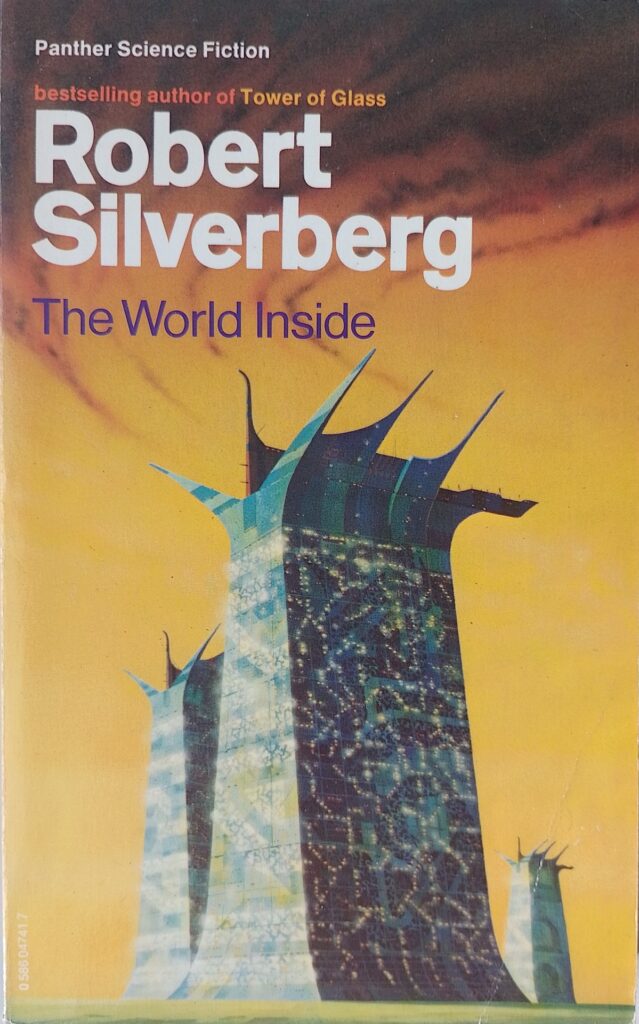First published 1971. Panther paperback, 1978, pp 188, c.63,000 words.
It seems strange now, but there were real fears about the consequences if the population explosion that happened after the second world war continued. Science Fiction writers of the golden age of the 1950s to the 1970s frequently addressed this issue with stories of gross overcrowding, and teeming, dysfunctional cities. Silverberg adds to possible outcomes with this fine book, and as usual, the solution he explores is highly original: let it rip. If the world is tightly enough organised, with the vast majority packed into towers with a powerful, coercive culture as well as bread and circuses, then the planet could cope with the seventy-five billion people he posits by 2381 [p34].
This is an exploration of how such a world might work, and the consequences for the inhabitants. It is not a conventional linear narrative, more a collection of stories with overlapping character sets.
Most of the population live in buildings called Urbmons, each three kilometres tall and housing over eight hundred thousand people. These standardised units are clustered in groups, replacing the old cities. The floors are stratified with workers at the bottom and the administrators at the top. There is more space for those at the top, but the difference is less than in our society. Inside the Urbmons is everything else needed by the people who live there. They never need to leave, and indeed, the world outside is frighteningly different. Outside is a separate civilisation that is devoted to agriculture and trades food for machinery with the cities. The culture of the Urbmons is oriented around increasing population. It is a quasi-religious duty to produce as many children as possible, and status follows, to some extent, family size. The people marry as soon as they are potentially mature: eleven or twelve typically – odd that, marriage, in such a sexually liberated culture. Perhaps it was so that the men have someone to keep home for them.
Silverberg does a fine job of building a coherent world around this premiss. It is almost plausible, although I suspect that the sums don’t quite add up and that the population explosion must surely outstrip the planet’s resources much earlier than stated. 100+ newborns are added every day in each building [p8]. The population within an Urbmon must rise very rapidly unless a lot of people are ‘disposed of’ or many are sent to new buildings to ease the pressure. Perhaps the maths aren’t important here: it is about the credibility of the culture.
This leads to the major flaw from the modern reader’s perspective: this culture is a young man’s fantasy world: the women are required to make themselves sexually available to allcomers. Men are expected to be ‘nightwalkers’ and drop in to any apartment they fancy at any time: there are no locks, and the ‘religious’ prejudice is such that it is unacceptable for a woman to refuse a man. Perhaps Silverberg is intending to horrify us and make us evaluate the power of the state and religions to coerce. He was writing as sexual liberation was well underway and he extrapolates from those changes. At one point he has a history researcher being appalled as he reads sexually-repressive laws from the twentieth century USA [p86].
Women also take on the typical mid-twentieth century role of homemaker, while the men have ‘real’ jobs outside the home, but always elsewhere in the building. However, these ‘real’ jobs are mostly make-work which machines could do better As one character thinks: ‘one must battle constantly against one’s own obsolescence if one is going to go on thinking of oneself as having a purpose in life’ [p52].
There are some excellent set pieces here. Among them are a music concert which is the apotheosis of prog-rock with a hugely overblown sound and light show. Another is when a character ventures outside and falls in with one of the farming communes. This provides a powerful scene out of The Rite of Spring. The only character that occupies two chapters is ‘Siegmund Kluver’ who is a Silverberg favourite type: the insecure, intellectual high-flyer: a Woody Allen character from his heyday.
Silverberg writes fluently, making this easy reading. There was one bit of Yoda speak: ‘Much he must do.’ [p109].
This is a horrifying vision of a dystopian future, that like ‘Brave New World’ might be appealing to a section of humanity, but which the rest of us should be on our guard to prevent.
Wikipedia biography of Silverberg: https://en.wikipedia.org/wiki/Robert_Silverberg
Wikipedia description of the book: https://en.wikipedia.org/wiki/The_World_Inside
Others’ reviews of the book: https://www.goodreads.com/book/show/261625.The_World_Inside?from_search=true&from_srp=true&qid=AM2lQIxLSL&rank=1
© William John Graham, May 2024

